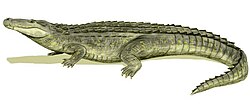| "Crocodylus" acer Temporal range: Eocene, | |
|---|---|
 | |
| Scientific classification | |
| Kingdom: | Animalia |
| Phylum: | Chordata |
| Class: | Reptilia |
| Clade: | Archosauria |
| Order: | Crocodilia |
| Species: | † "Crocodylus" acer Cope, 1882 |
| Binomial name | |
| †"Crocodylus" acer | |
"Crocodylus" acer is an extinct species of crocodyloid from the Eocene of Utah. A single well preserved skull was described by paleontologist Edward Drinker Cope in 1882 and remains the only known fossil of the species. It was found from the Wasatchian-age Green River Formation. "C." acer had a long, narrow snout and a low, flattened skull. [2]
Some postcranial bones have been attributed to "C." acer but they have more recently been suggested to belong to the related species "C." affinis . [3] Although they were first placed in the genus Crocodylus , "C." acer and "C." affinis are not crown crocodiles. Recent studies place them as early members of Crocodyloidea, only distantly related to Crocodylus. Although it represents a distinct genus, a generic name has not yet been proposed for "C." acer.


